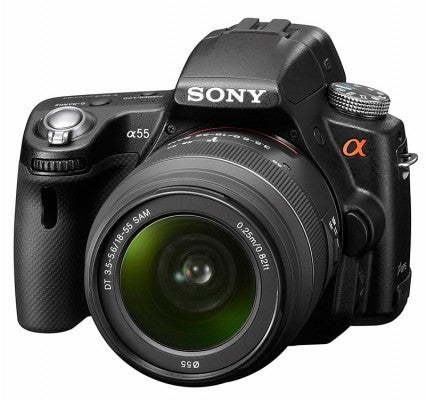Sony's new Alpha a33 and a55 are bursting with new technology, but what should we call them, asks Nigel Atherton
Anyone who watches Doctor Who will be familiar with the reaction of those who get to peek inside the Tardis and discover that it’s bigger on the inside than the outside. I felt a bit like that when I put Sony’s new Alpha ‘DSLR’, the a55, to my eye for the first time and found there was an electronic viewfinder (EVF) inside the eyepiece.
The term DSLR, or Digital Single Lens Reflex to give it is full name, describes the through-the-lens, mirror and prism viewing system that defines those cameras, and results in the optical viewfinder system that DSLR users know and love. It’s what makes a DSLR a DSLR. So Sony’s latest models, the a33 and a55, are not really DSLRs at all, because although they have a 45° mirror inside, they feature an electronic viewfinder rather than an optical one. Yet they look like DSLRs, handle like DSLRs and use the same interchangeable lenses as Sony’s other DSLRs. So what the hell are they?
Time was when there were two kinds of digital cameras: compacts and DSLRs, Then came bridge cameras (which are too big to be called compacts but have fixed lenses) and more recently the new generation of compact style cameras with interchangeable lenses – or Micro System Cameras (MSC) as we call them. Now, with these new Sonys, it looks like we’re going to have to build another pigeon hole.
For the sake of our sanity I think we’re still going to call them DSLRs, at least for a while, because the alternative is to call them what Sony says they are, which is DSLTs, or Digital Single Lens Translucent cameras. Yes, it’s a ridiculous name, and there’s no way we can call them that without following it with a paragraph of explanation as to what that is (which will get pretty tedious after a while). Even if we continue to call them DSLRs we should really follow that with a disclaimer in brackets along the lines of ‘yes, pedant, we know they’re not strictly DSLRs but you know what we mean’.
Alternatively, and perhaps this is the best solution, is to call them DSLR-style. Even this isn’t ideal because some MSCs could also be described as DSLR style (the Samsung NX10, for example), but it might have to do. These new Alphas will have to live in the DSLR section of this website, and our magazine Buyers Guide, because we’re not going to create a special section just for them.
So enough about what we call them, what will the photographic community think of them? Do they represent the brave new world for digital cameras, harbingers for the future, or are they the result of some grotesque photographic Frankenstein experiment? A dogs head on cat’s body, so to speak.
There’s no doubting the user benefits this technology provides: 10 frames per second, Live View and HD video through the viewfinder, all with super-fast and accurate full-time phase-detection AF. The translucent mirror has been seen on an SLR before, on the Canon EOS RT, launched in 1989, but that camera was criticised for its dark viewfinder (dark because only 30% of the light hitting the mirror went to the viewfinder – the rest went to the film). Despite Sony claiming that their translucent mirror is 30% brighter than Canon’s (which I can well believe, given the 30 years of technological progress since the RT) Sony clearly felt that the viewfinder still wasn’t bright enough and opted instead for the EVF. Millions of people use bridge cameras and MSCs with EVFs perfectly happily, but they are the marmite of photography and not to everyone’s tastes. Personally, although I quite like marmite, I am yet to be entirely won over by EVFs.
But that’s just me, and despite my conservative and, some would say, irrational feelings about EVFs I am convinced that these cameras (which, lets not not forget are at the entry level end of the price spectrum) offer such a great spec for the money, and so many benefits over rival DSLRs, that they will be massive sellers and could be the biggest challenge yet to the dominance of Canon and Nikon in the ‘DSLR’ sector.
What I’d really like to see is a replacement for the superb but now discontinued Alpha a700, one of Sony’s finest DSLRs, that uses the translucent mirror but sticks with an optical viewfinder and manages to make it bright enough to be useable. If Canon could do it it in 1989 I’m sure Sony can do it in 2010.





